What the ... ?
It’s a bug-eat-bug world out there, folks! This fact was in full display this morning. A colorful predatory bug was having a nice drink from a caterpillar. I’m not going to ask you what that caterpillar was because I’m not entirely sure. May be a royal moth caterpillar or oakworm.
What’s the name of that colorful predatory bug?
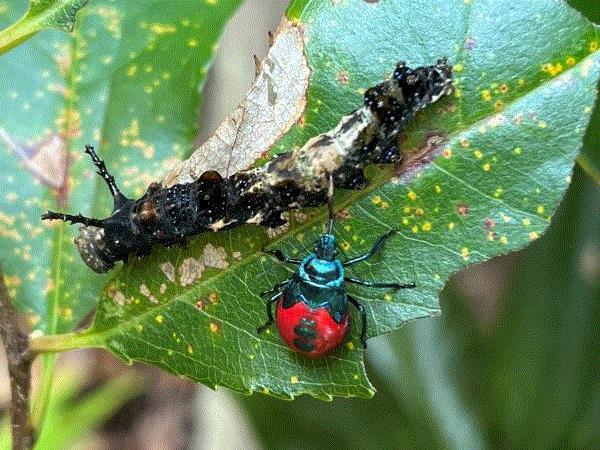
See any muhlygrass mealybug?
I would like to ask y’all to help me with a project. My former PhD student, Cory Tanner, is conducting a survey on where the muhlygrass mealybug is distributed and how it’s managed in different communities. So, if you have muhly grass or a species or cultivar of Muhlenbergia, please take a look and see if they are infested by the distinctive mealybugs. I would appreciate it if you use this online reporting tool to let Cory know what you find, even if you didn’t see any infestation. A data point of zero is still a data point.
Muhly grass is a group of native ornamental grass species that’s gaining popularity as a landscape plant. It’s certainly becoming more popular in southern landscapes in the past couple of decades, perhaps because they look like sweetgrass, which is culturally important to the coastal communities. Wild muhly grass is a component in making the famous sweetgrass baskets in South Carolina.
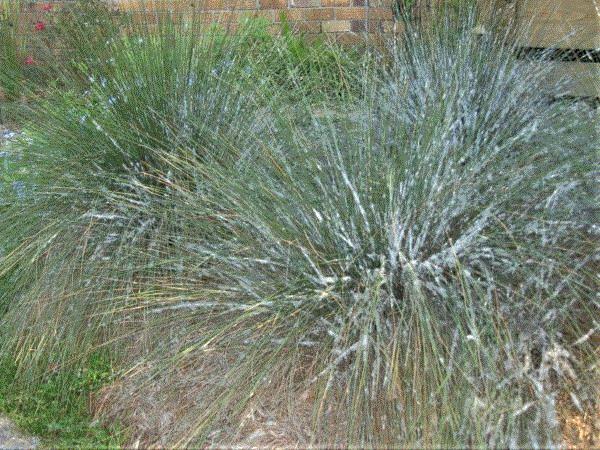
Muhly grass infested by the muhlygrass mealybugs look like they are covered with snow. (Photo credit: Merle Shephard, Clemson University)
Some muhly grass in Charleston, South Carolina, looked rather odd starting in 2018. Some of the grasses, which typically have no pests, were covered with snow-like deposits. Merle Shepard, a Professor Emeritus at Clemson University, found an infestation in his neighborhood and collected some specimens for identification. It turned out to be a mealybug species that’s new to South Carolina, called the muhlygrass mealybug. This species was previously known only from Florida. Cory’s project aims to understand where the mealybugs are, how far they can spread, and develop management approaches against the mealybugs. This survey is part of Cory’s effort to collect distribution data on this species.
Please take a picture to go along with your report. Your participation is confidential. The data collected will not be shared with anyone, including plant inspectors and other regulators, since this mealybug species isn’t a regulated pest. Your participation is voluntary and greatly appreciated.

See any Thrips parvispinus in the landscape?
I participated in a Thrips parvispinus workshop early this week. This traveling workshop was organized by the University of Florida Extension Service and traveled to three southern Florida counties—Palm Beach, Broward and Miami-Dade.
The workshop focused on providing the most recent information on this invasive thrips species to growers and landscape care professionals in the three counties. Experts on this pest, including Alexandra Revynthi, Lance Osborne, and John Roberts of the University of Florida, Cindy McKenzie and Zee Ahmed of USDA-ARS, and representatives from Florida Department of Agriculture and Consumer Services, talked about the biology, distribution, scouting, management, and regulatory practices against this invasive pest. Nancy Rechcigl of Syngenta, Gilbert del Rosario of Corteva, and I, representing SePRO, participated as panelists in discussions.
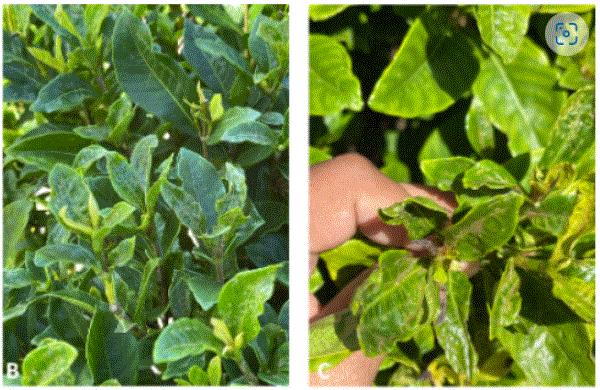
Damage on a gardenia hedge. (Photo from Thrips parvispinus Resources)
I’m not going to summarize everything I heard from the workshop here. If you want to know more, email me or access the resources I listed at the end of this section.
A piece of information that perked my ears is that Thrips parvispinus has been found in landscapes in five Florida counties, with the majority of detections from Palm Beach, Broward and Miami-Dade counties. This thrips was also found on plants sold in almost all retail stores the team had surveyed. A long list of plant species is affected, but three species stood out as the most infested in the landscape—gardenia, dipladenia (mandevilla), and pinwheel jasmine. There has not been any report of establishment in landscape outside of Florida.
Now, I’m not putting this piece of information out to scare y’all. I simply want to introduce the possibility of establishment in landscape in your mind, and perhaps to prepare you for something that may come. Lance mentioned during the workshop that the progress of this “Thrips parvispinus issue” follows very much of progression of most invasive species—first, folks know about the pest and are concerned, then they get scared and think the sky is falling (which is the stage we are in now), but finally everyone realizes the new pest can be controlled and calm down. I would echo that progression of stages and emotion, and hope that the stage of calming down arrives sooner rather than later.
GO HERE for a recent GrowerTalks article from Zee, Cindy and Lance on the status of this pest, and GO HERE for a website with lots of useful information (including scouting and identification guide and list of known hosts) for this invasive thrips species.

Poinsettia abnormalities
Don’t be fooled by the previous section titles. I don’t ONLY ask people if they’d seen this bug or that bug. I’m a bug nerd, but I ask about something else, too. One of these frequently asked non-bug questions is “Do you know where your dog is?” But that has been replaced recently by “How’s your poinsettia crop doing?”
Words on the street is that this year’s poinsettia crop is getting off to a good start. Many growers also confided that they probably won’t grow poinsettia if they have a choice. It’s a ... how should I put it? Finicky crop. A lot of care is needed to grow a good crop because the entire growing process is so dependent on having a good environment. Lots of weird things can happen not only because of pests or diseases but also because of environmental issues.
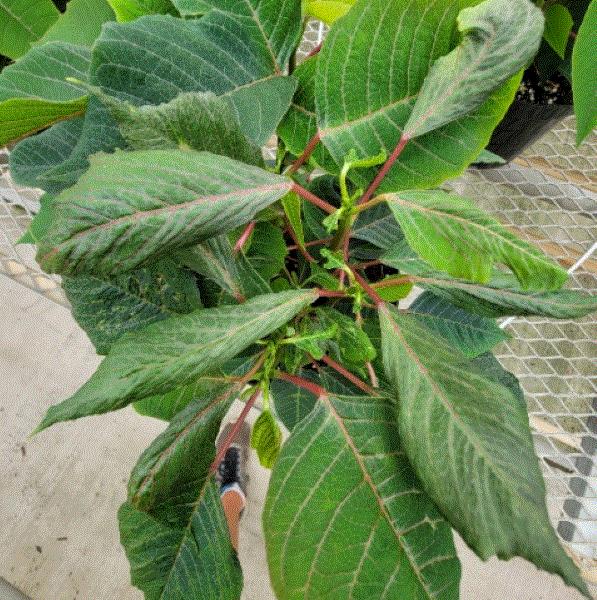
Leaf distortion on poinsettia caused by unfavorable environment. (Photo from e-GRO article by Roberto Lopez and Heidi Lindberg.)
Roberto Lopez and Heidi Lindberg of Michigan State University published a great e-GRO Alert article in October 2021. The article outlines various abnormalities that may happen to a poinsettia crop—from fasciation due to heat (the picture above was what happened to my crop), phosphorus toxicity, leaf scorch, poor form, phytotoxicity from pesticide application, etc., you name it. The central theme is the importance of reducing environmental stresses, such as heat stress experienced during the hottest part of the year.

Take the annual Wage & Benefit Survey
The annual GrowerTalks/Green Profit Wage and Benefit Survey is here. This is the longest continuously running and most accurate survey of wages and benefits in our industry! It’s the 28th year for the GrowerTalks survey (for growers) and the 15th year for the Green Profit survey (for retailers).
This year’s survey is a bit different from those in the past. First, Ball Publishing is partnering with AmericanHort in this survey. And there will be more questions in this year’s survey than in the years past. These additional questions will help Ball Publishing and AmericanHort to drill deeper into the prevailing wage and benefit issues and the labor and wage challenges faced by growers and retailers.

GO HERE to take the survey before October 6th. By participating in the survey, you will have an opportunity to enter a drawing for a Yeti Tundra 45 Hard Cooler (a $325 value).
Results from the surveys will be published by GrowerTalks in December and Green Profit in January. Respondents to last year’s survey said that they’d increased wages and benefits but still faced significant challenges from labor shortages. Last year’s survey results are published in GrowerTalks and Green Profit. Would it be different this year? Will there be new challenges this year? Help us find out by participating in the Wage & Benefit Survey.

HRI offers a webinar on ambrosia beetle management
Every entomologist has been asked what their favorite bug is. I’m not shy about saying that scale insects and mealybugs are my favorites. (Okay, okay, scales and mealybugs aren’t singular. What can I say? I’m greedy!) When it comes to the question of what’s the second favorite, well, that can be difficult. I have several candidates, but ambrosia beetles certainly are on the top of the candidate list.
Ambrosia beetles are major pests in nursery tree production throughout the world. Granulate ambrosia beetle and black stem borer cause tree losses every year. There’s the black twig borer, which causes flagging of southern magnolia terminals in my neck of the woods. I talked about redbay ambrosia beetle affecting coastal ecosystems in the past, but it and several other species are also big threats to avocados. Shoot, there are even species that bore into coffee beans! Surely, pests that prevent you from getting your fill of avocado and coffee should get your attention.
In the 1980s until about 10 years ago, research on how to best control ambrosia beetle was moving slowly. We couldn’t design experiments to look at management because we knew so little about the behaviors of the beetles and we didn’t have a reliable method to evaluate insecticide efficacy. In fact, Peter Schultz (Professor Emeritus at Virginia Tech) once advised me (when I was still a newly minted young assistant professor) not to work on ambrosia beetles before I get my tenure because it’s hard to work with an unpredictable insect. But now we know a lot more and we can do a lot more to prevent beetle attacks and manage them when necessary.
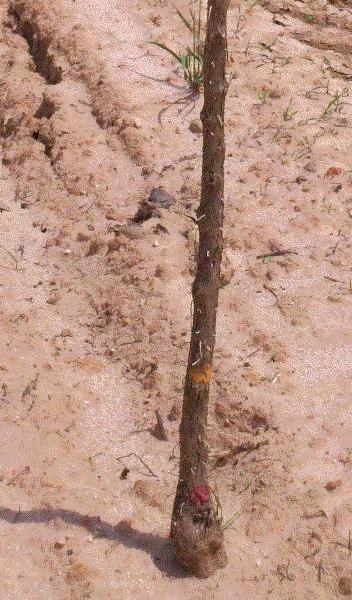
A dogwood attacked by ambrosia beetles, showing frass tubes created by the beetles.
I would give much of the credit to Chris Ranger of USDA-ARS and his hard-working colleagues. This team of researchers have figured out what makes the ambrosia beetles tick. Now we know so much more about how and why the beetles attack trees. Using that knowledge, we improved the methods to trap or monitor them, to prevent attacks and to manage the beetles. Chris will be summarizing his body of knowledge and findings from a USDA Specialty Crop Research Initiative (SCRI) grant project (which I’m also a part of) in a webinar hosted by the Horticultural Research Institute at 1 p.m. Eastern on October 4.
Sign up for the webinar before October 4th! You can find out more about the outcomes of the SCRI-funded ambrosia beetle management research project by going HERE.

Answer to “What the … ?”
The colorful predator is a nymph of the Florida predatory stink bug. Now, don’t be fooled by the common name—this predatory bug is more than just a Floridian. It’s widely distributed in the eastern United States and southward through Mexico to Brazil.
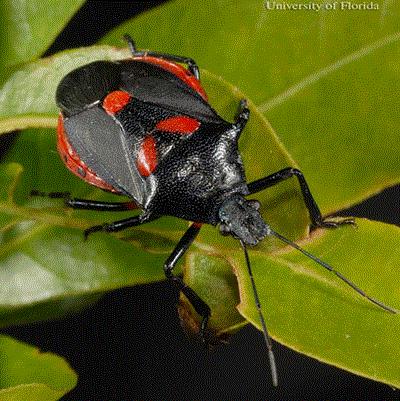
An adult Florida predatory stink bug. (Photo credit: Lyle Buss, University of Florida)
This is a stink bug species and a common predator of many insects, such as caterpillars, beetles and other stink bugs. What you are seeing in the picture is a fourth-instar nymph. The adults have fully developed wings that cover the abdomen, and yellow or red spots on the back. Very distinctive! Now that you’ve seen it here, you won’t ever forget it.
GO HERE if you want to find more information about this common beneficial insect.
See y’all later!

JC Chong
Technical Development Manager at SePRO
Adjunct Professor at Clemson University
This e-mail received by 27,847 subscribers like you!
If you're interested in advertising on PestTalks contact Kim Brown ASAP!